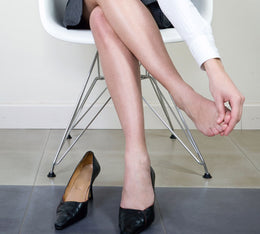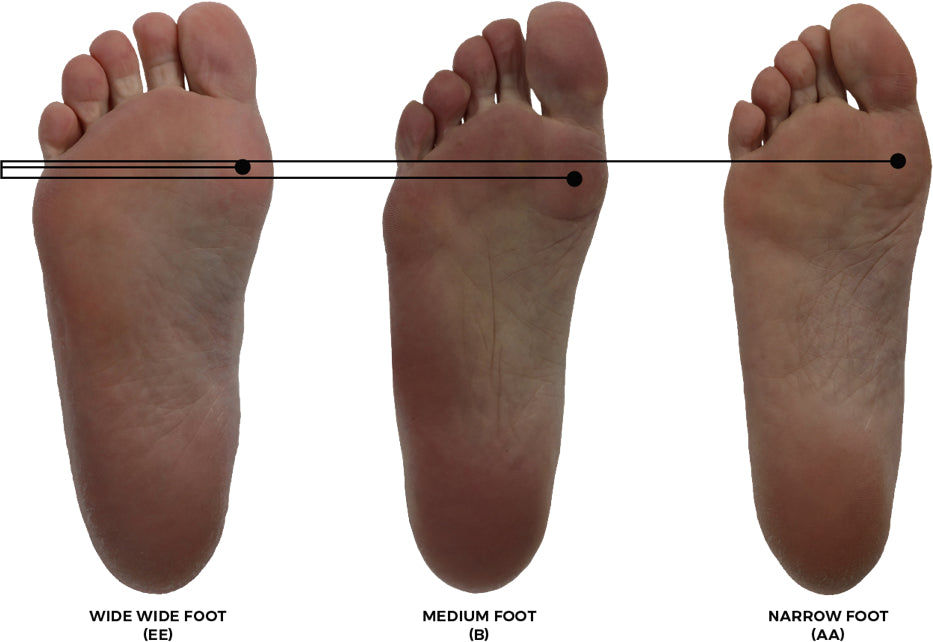Fit Your Foot
It's time to say "Yes!" to comfort.
No doubt all shoe-lovers have squeezed into a pair of shoes for the sake of style at some point in their life.
Besides any immediate pain from pinching, wearing poor-fitting footwear can cause blisters, calluses, bunions, hammertoes, and corns, leading to pain and discomfort in your later years.

DID YOU KNOW…
-
25% of your bones are located in your foot.
-
Every walking step you take exerts pressure up to three times your body weight on your feet.
-
The average American will spend approximately half of their lives in shoes.
-
Nearly 90% of women wear shoes that are one size too small.
-
Women are four times more likely to experience foot problems than men.
Munro offers up to 15 sizes and 5 widths ... That's the FIT difference!

Within a style, select colors are offered in up to 15 sizes: from 5 to 11 , 12, and 13.
There is approximately 1/6” between size increments, so a size 9 is 1/6” longer than an 8.5 and 1/3” longer than a size 8.

Various styles and colors are offered in as many as 5 widths: Super Slim (4A), Narrow (2A), Medium (B), Wide (D), and Wide Wide (EE).
There is approximately 1/4” difference between widths, so a Medium width is 1/4” wider than an 'A' and 1/2” wider than a Narrow (AA).
MUNRO SHOES SIZE CHART

QUICK SHOE FINDER
GETTING THE RIGHT FIT
TIPS ON HOW TO FIND THE BEST FIT
-
Visit a full service retailer to have your feet professionally measured so you get the best fit possible.
-
Have your feet measured using a Brannock or similar device and always measure both feet, as they are often different sizes.
-
Try shoes on at the end of the day since your feet normally swell and become larger throughout the day.
-
Stand up during the fitting process and be sure to walk around in the shoes before purchasing.
-
Try on shoes with the same type of stockings/socks you will wear with them and if you normally wear orthotics, take them to the fitting.
-
A shoe should be comfortable immediately upon trying on, do not expect tight shoes to loosen up with wear.
-
Look for shoe toe shapes that reflect the shape of your foot. A long straight foot may not fit well into a shoe that has a broad oblique shape, and vice versa.
Important Fit Tip: Pay Attention to your Arch Length!
What is that?
Arch length is the distance from the ball of the foot to the back of the heel. People can have the same overall foot length but different arch lengths depending on whether they have long or short toes. For shoes to fit properly it is critical for the ball of your foot to rest in the widest part of the forepart of the shoe, which is where the shoe is designed to bend during walking.
If you have short toes and buy a shoe that fits to the end of your foot, it may be too short for your arch length. This means the ball of your foot is in front of the 'flex point' of the shoe, cramping the toes and compressing the foot, causing discomfort.
How do you find your arch length?
The use of a Brannock or similar device is the best way to measure your arch length. Most full service shoe stores have Brannock devices and staff who are trained to use them.

Foot Differences
All three of these feet are a size 8 in length, but various widths.
They highlight some of the structural differences that make fitting shoes a challenge.

The Medium Foot
The Medium foot has the arch length that is appropriate for our size 8 shoe. The Narrow foot has an arch length that is 1/3” longer, so it should be fitted in an 8.5.
If she were to wear an 8, her foot would be squeezed as she walks because the widest part of her foot would not be in widest part of the shoe. Ouch!
The Narrow Foot
In the Narrow foot, the outside is not much darker than the arch. This indicates that the Narrow Foot is transferring weight from the ball of the foot directly to the heel, without 'help' from the outside of the foot, so the arch is getting more stress. This creates foot fatigue, discomfort and possible mechanical problems down the road. Not very happy feet, huh?
Medium and Wide Feet
Medium and Wide feet can also have this issue which is why Munro puts steel shanks in almost all their shoes to provide support and reduce foot strain.
What Can We Learn?
-
Notice that the toes of the Wide Wide foot are shorter than those of the Medium or Narrow. This foot will have more room at the end of her shoe than the Medium or Narrow foot, which may make her think that her proper size is too big. You must fit the shoe based on the arch length.
-
The arch length is the distance from the center of the 1st metatarsal joint (the one at the ball of your foot under the big toe) to the heel. A black line has been drawn from the measuring point for arch length on each foot to the left hand side of the page so you can see the variation.
-
The darker areas indicate where the foot impacts the ground. You can see that the Wide Wide and Medium foot put weight on the outside of the foot, which is normal, because the foot is designed to transfer weight from the big toe across the ball to the outside of the foot and then down the length of the foot to the heel.
